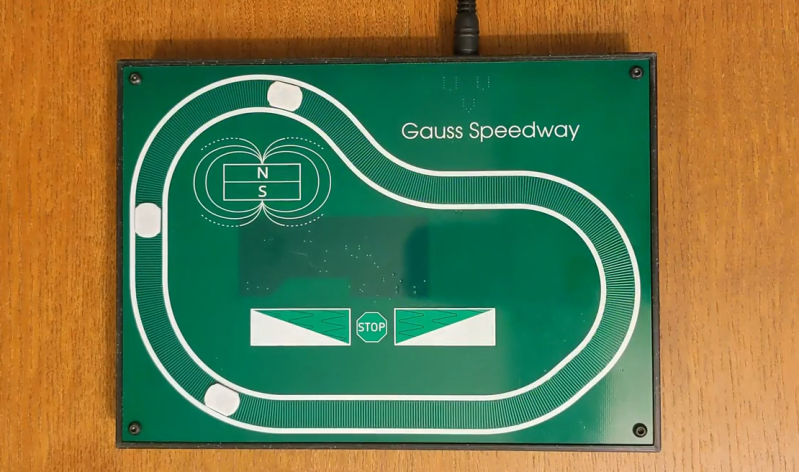Carl Friedrich Gauss was, to put it mildly, a polymath responsible for a large percentage of the things we take for granted in the modern world. As a physicist and mathematician he pioneered several fields of study including within the field of magnetism. But since he died decades before the first car was built, it’s unlikely he could have imagined this creation, a magnetic slot-car race track called the Gauss Speedway by [Jeff McBride], which bears the name of the famous scientist.
The Gauss Speedway takes its inspiration from a recent development in robotics, where many small robots can travel around a large area with the help of circuit traces integrated into their operating area. With the right current applied to these traces, magnetic fields are generated which propel the robots. [Jeff] wanted to build something similar, integrated into a printed circuit board directly, and came up with the slot car idea. The small cars have tiny magnets in them which interact with the traces in the PCB, allowing the cars to move with high precision around the track. He did abandon the traditional slot car controller in favor of a push-button style one directly on the PCB too, which means everything is completely integrated.
While this was more of a demonstration or proof-of-concept, some of the features of this style of robot can be seen in this video, which shows them moving extremely rapidly with high precision, on uneven surfaces, or even up walls. Magnetic robots like these are seeing quite a renaissance, and we’ve even seen some that use magnetism to shape-shift.
















That is amazing, I could see a bunch of tracks that could be connected together using this method to make a large race course.
The more complex version is currently under construction in the “Miniatur Wunderland”, recreating the Monaco Formula 1 Grand Prix course:
https://www.youtube.com/watch?v=MMtI9ERPerg
Hehe you were seconds faster…
Haha, when i read the title i thought the article was about this.
Seems to be the same principle they’re using for the Monaco F1 track in the Miniatur Wunderland in Hamburg: https://www.youtube.com/watch?v=-MX09NzQAKE
Only in Hamburg they plan to let 20 cars simulate a full race on a 21m track…
Witchcraft!
Magnets! (How do they work?)
Related: https://hackaday.com/2022/05/19/pcb-linear-motors-for-model-trains/
How long before someone takes a similar approach, but creates a seven segment display, where the pieces move in/out of frame?
I want it!
Glad to see I’m not the only one who designed and programmed a two lane Gauss track only then to find what should have been obvious: the magnets will just stick to each other! https://youtu.be/3JAXp0J8rKA
https://engineer.john-whittington.co.uk/2021/06/16/linear-clock.html
The comment in the YouTube video says: “This video will likely be removed soon. See Vimeo link for long term version.” To future-proof the Hackaday user-experience here is that improved no-ads Vimeo link:
https://vimeo.com/771275219
reminded me of this HaD article: https://hackaday.com/2022/05/19/pcb-linear-motors-for-model-trains/
trains, with points etc too:
https://youtu.be/5xuinIyKx2g
1:220 scale racing cars
https://youtu.be/kyXnJp0l2j8
I work with stepper motors and drivers. It seems to me that a driver, such as a DRV8825 can drive two windings. That would get motion in a single axis/track.
A duplicate of that system, rotated 90 degrees from the first would get you a two dimensional space where you could move a single magnet anywhere/any way.
if you want some serious motion control (speed or position), replace the drivers with a “Tic T825 USB Multi-Interface Stepper Motor Controller” https://www.pololu.com/product/3130
If someone actually tries this, I’d like to hear about it.